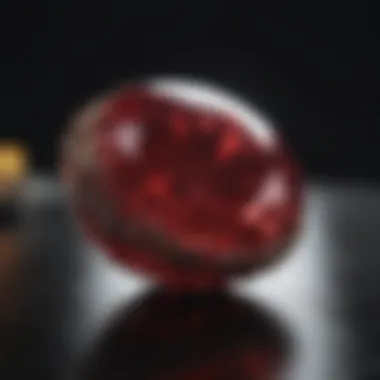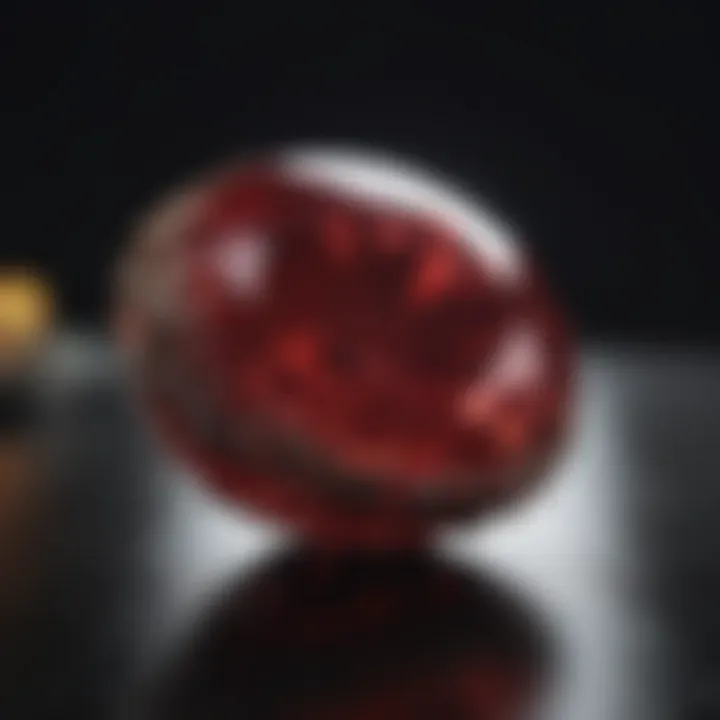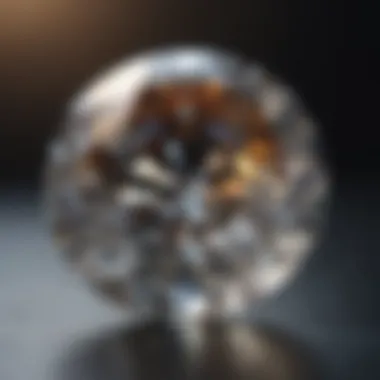Exploring Valuable Gemstone Investments


Intro
Gemstones have long been associated with wealth and beauty, capturing the imagination of collectors, investors, and jewelry designers alike. Although often seen only as decorative items, their potential as a smart financial investment is one worth exploring. This article aims to present an in-depth examination of gemstone investments, shedding light on what makes these radiant rocks financially viable.
In the upcoming sections, we will break down various elements that amplify the value of gemstones, dive into their historical background, and discuss practical tips for making informed investment choices. Whether you are a seasoned gemstone enthusiast or a newcomer curious about the market, understanding the intricacies of gemstone investments can help in enhancing your portfolio while appreciating the allure of these dazzling stones.
Gemstone Overview
Definition of Gemstones
Gemstones are naturally occurring minerals or rocks that have been cut and polished to be utilized in jewelry and ornamentation. They are prized for their beauty, rarity, and durability, often being associated with various cultural and emotional significances. The allure of gemstones goes beyond their aesthetic appeal; when adequately evaluated, they can serve as valuable investments.
Classification of Gemstones
Gemstones can be broadly classified into two categories: precious and semi-precious. This classification hinges on their rarity, value, and historical significance.
- Precious Gemstones: Includes diamonds, emeralds, sapphires, and rubies. These stones are often considered the crème de la crème due to their beauty and relative rarity. Their market demand remains consistently high, which, in turn, affects their investment potential.
- Semi-Precious Gemstones: Encompasses a wide range, including amethyst, garnet, and aquamarine. Although typically less valued than precious stones, many semi-precious gemstones are gaining traction in the investment community. Their appeal can be tied to growing trends and a burgeoning collector base.
Knowing the distinction and characteristics of each can provide context when assessing possible investment opportunities.
Historical Significance
Origins of Gemstone Use
The use of gemstones finds its roots in ancient civilizations, where their dazzling visuals were often imbued with spiritual or astrological beliefs. The Egyptians adorned their pharaohs and tombs with lapis lazuli and turquoise, believing these stones possessed protective properties. As history progressed, gemstones continued to find their way into royal crowns and scepters, symbolizing power and status.
Cultural Insights: Gemstones in Ancient Civilizations
Throughout history, various cultures have attributed different meanings to gemstones:
- India: Gemstones like diamonds and rubies are included in Vedic astrology, dictating their auspiciousness and their roles in influencing fortune.
- Greece: The ancient Greeks believed that amethyst could guard against intoxication and was linked with Bacchus, the god of wine.
- Rome: Garnets were prized for their vibrancy, often believed to enhance the beauty of their wearers.
These cultural significances not only enrich the lore surrounding gemstones but also have several implications for their market values today. A deeper understanding of their historical context can open new avenues for making wise investment decisions.
A gemstone’s history adds another layer to its value. Knowing that a sapphire adorned a crown can make it far more attractive than a stone without such a story.
As we navigate further into this exploration, we shall delve into pressing factors that influence gemstone value, contemporary market dynamics, and strategies that can pave the way for successful investments.
Intro to Gemstone Investment
The world of gemstone investment has been a fascinating and often overlooked avenue for many investors. As markets fluctuate and traditional investment vehicles waver, gemstones present a tangible asset that not only holds intrinsic beauty but also the potential for significant financial growth. Understanding the nuances behind gem investment is crucial for anyone considering diversifying their portfolio with these sparkling wonders.
Investing in gemstones can be advantageous for several reasons. First off, they often retain value over time, sometimes even appreciating when economic conditions are less than favorable. Unlike stocks or bonds, they are immune to market volatility in the same way. Furthermore, gemstones carry a sense of prestige and can be worn or enjoyed while waiting for their value to rise, merging passion and profit in a rare way.
Even so, potential investors ought to tread carefully. Knowledge is power, and without ample understanding of the market dynamics, one might end up with a collection of rocks instead of assets. Factors such as rarity, quality, certification, and market trends all play pivotal roles in determining the worth of gemstones.
"Gemstones are not just accessories; they are a tangible investment rooted in heritage and luxury."
In this section, we delve deeper into the intricate world of gemstone investment.
Understanding Investment in Gemstones
Gemstones have captivated human interest for millennia, regarded not only as symbols of beauty but also as economic commodities. Entering this realm necessitates an understanding of how value is assigned and retained. Gemstones are unique in that their worth is derived from a blend of market demand, scarcity, and the perceived quality of each piece. The elements that contribute to their valuation are deeply integrated, much like the layers of a well-cut diamond.
Investors must familiarize themselves with key concepts such as cut, clarity, color, and carat weight which, collectively referred to as the "Four Cs," heavily influence a gemstone’s market value. Each of these elements plays a distinct role—poor clarity can drastically reduce a gem’s worth, while exceptional color can propel it to new heights. Furthermore, to be recognized as a viable investment, gemstones ought to come with proper documentation and certifications from reputable labs.
Historical Context of Gemstone Value
Throughout history, gemstones have held profound cultural and economic significance. As far back as ancient civilizations, precious stones were seen as more than mere adornments. They were thought to carry magical properties or symbolize status and power. For example, kings wore rubies not only for their beauty but also for their perceived ability to protect in battle.


During the Renaissance, gems became investments in art, reflecting wealth and refined tastes. Fast forward to modern days, and the demand for rare stones like pink diamonds has skyrocketed, leading to record-breaking auctions. This historical perspective provides insight into how cultural trends and societal values can influence gemstone prices and desirability over time.
By understanding the historical context behind gemstone valuation and the theories that fuel today’s market, investors can gain a clearer picture of where to focus their attention when considering purchases.
Factors Influencing Gemstone Value
Understanding the myriad factors that influence gemstone value is crucial for any investor or collector embarking on this unique market. The allure of gemstones goes beyond their vibrant colors and aesthetic appeal; several specific elements contribute to their worth. These factors can be broadly categorized into rarity and supply, quality and certification, and current market demand and trends. Familiarizing oneself with these aspects can not only aid in making informed purchasing decisions but also help identify opportunities for potential appreciation.
Rarity and Supply
Rarity lies at the heart of gemstone investment. Just like fine wine or rare art, a gemstone's scarcity elevates its value significantly. For instance, some gemstones, like pink diamonds, are nearly non-existent in nature, making them incredibly sought after. The interplay between rarity and supply can create price spikes; when a particular gemstone becomes far less accessible, its value may soar, much like an old record that nobody can find.
Several mines across the globe, such as the famous Argyle mine in Australia, have exhausted their resources, leading to a tightening supply. Consequently, investing in gemstones sourced from depleted or restricted mines can yield considerable returns. Suppliers may have smaller quantities, and that could indicate potential appreciation over time. People say, "what's rare is valuable," and in the gemstone world, this couldn't ring truer.
Quality and Certification
Understanding Grading Systems
When it comes to gemstone quality, grading systems play an essential role in determining value. Well-established grading systems categorize gemstones based on several criteria: color, clarity, cut, and carat weight. A gemstone assessed with high grades in these categories can fetch significantly higher prices than its less impressive counterparts.
The key characteristic of these grading systems is their objectivity; they provide potential buyers with concrete metrics to work from. For instance, a brilliant-cut diamond with near-colorless clarity and excellent proportions has marked advantages over others that may have visible inclusions or lower grades. Knowing this, investors will often prioritize gemstones that come with reports from respected labs to ensure the quality is verifiable.
However, it’s worth noting that grading also carries disadvantages. Sometimes, personal biases of the graders may cloud assessments, leading to inconsistencies in gemstone valuation. Therefore, while grading systems are beneficial, one must remain discerning.
The Role of Certification Labs
Certification labs serve as giants in the gemstone field, providing authentication and grading to build buyer confidence. Renowned labs, such as the Gemological Institute of America or the American Gem Society, offer reports that outline the characteristics and authenticity of gemstones.
The importance of these labs cannot be overstated; their evaluations lend credibility to any gemstone purchase, significantly affecting resale value. With a trustworthy certificate in hand, investors can sell their gems at a premium, knowing they have robust backing. Each report can sometimes even add a historical aspect, detailing the gemstone's journey, which can resonate with potential buyers.
That said, buyers should beware that not all labs hold the same reputation. Some less known or uncredentialed labs may produce questionable reports that could damage investments. Hence, buyers must rely exclusively on respected institutions to ensure quality and authenticity.
Market Demand and Trends
Finally, understanding market demand and trends is paramount. The preferences of a generation can shift over time, affecting what gemstones are deemed valuable. For example, in recent years, there has been a growing appreciation for ethically sourced and lab-created gemstones, impacting the purchasing behavior of modern consumers.
Additionally, social media has proven to be a double-edged sword; it can elevate a gemstone to stardom, or it can turn popular opinions completely upside down within days. Trends often cycle, and keeping an ear to the ground can offer significant insight into potential investments. Staying informed through social media platforms, gemstone forums, and market analyses can provide clarity about what to consider when entering the market.
In summary, grasping the complexities of rarity and supply, quality evaluation, and shifting market trends provides a robust foundation for navigating the gemstone investing landscape. For anyone looking to break into this field, a meticulous approach to these factors can significantly enhance decision making and increase the likelihood of a rewarding investment.
Top Investment Gemstones
The realm of gemstone investment is a fascinating one, characterized by its mix of beauty, rarity, and value. In this section, we explore some of the most coveted gemstones that investors tend to lean toward. The intrinsic qualities of these stones often lead to long-term appreciation, making them a more than just pretty ornament. For folks in the investment scene, understanding the nuances of these particular gems plays a crucial role in making well-informed choices.
Well-chosen gemstones can add remarkable diversity to an investment portfolio while serving as artifacts of beauty and culture.
Diamonds: The Classic Investment
Diamonds have long held a prestigious position as the quintessential investment gemstone. Their dazzling appearance and historical significance establish them not just as luxury items, but symbols of wealth and success. When considering diamonds, investors often look at the "Four Cs": Cut, Color, Clarity, and Carat Weight. Each of these factors contributes to not only the value but also the desirability of the diamond.
Investing in diamonds can be a bit tricky, however. The market is not as transparent compared to other assets. So, buyers should be vigilant. Their price can fluctuate based on market dynamics and consumer trends. Therefore, owning diamonds might require a mix of market knowledge and passion for the stone.
Emeralds: Value Beyond Color
Emeralds carry a rich history intertwined with different cultures around the globe. Their lush green hue brings to mind opulence and vitality. Unlike some other gemstones, the quality of emeralds can be notably impacted by inclusions, which can actually enhance their charm and value. This makes the examination of their quality a rather specific affair, requiring a trained eye.
Emerald investment is often about the source. Colombian emeralds, for instance, are celebrated for their deep color and fewer inclusions, making them more sought after than others. Valuing a well-cut Colombian emerald typically requires patience and a habit of keeping abreast of market trends.
Rubies: The King of Gemstones


Referred to as "The King of Gemstones," rubies are known for their striking red tones and brightness. They are often associated with power, luxury, and even passion. Rubies are more than just beautiful; they are one of the rarest gemstones out there, making them highly valued. The intensity of color and absence of flaws significantly boosts their worth.
Investors often focus on untreated rubies, as these retain more value compared to their treated counterparts. Still, the ruby market can be volatile. Prices can soar following a high-profile auction, and dip just as quickly based on jade market fluctuations, which is why it is prudent to keep up with market movements for anyone interested in investing.
Sapphires: Versatility in Investment
Sapphires are not just blue; they come in a multitude of colors, which makes them exceptionally versatile. They symbolize wisdom and nobility, and they have made their mark in the world of investment. While blue sapphires are often considered king, those of other colors (known as fancy sapphires) can also fetch impressive price tags. This wide color palette invites a diverse customer base, enhancing their investment potential.
An essential point for investors is the attention towards origin, as gemstones from regions such as Kashmir or Burma possess an allure that can significantly elevate their price. Sapphires also tend to have a large market, offering a good balance of liquidity and long-term investment stability.
Tanzanite: A Unique Opportunity
Hailing from a single-source region in Tanzania, tanzanite is often perceived as a unique investment opportunity. The deep blue-violet hues of tanzanite create a subtype of investment that remains relatively unexplored compared to other gemstones. Their limited availability due to the region's diminishing supply makes tanzanite an intriguing option when thinking of future valuation.
Having first entered the market in the late 20th century, tanzanite possesses a youthful charm and is loved for its distinctive color and brilliance. Investors should be aware of its relatively short time frame in the investment scene, and thus the potential market fluctuations tied to that specificity.
Alexandrite: The Color Changer
Alexandrite is often hailed as the "chameleon" of gemstones due to its unique color-changing properties. In daylight, it can appear a lush green, while under incandescent light, it shifts to a brilliant red or purplish hue. This remarkable characteristic increases its allure and, consequently, its value.
As a rare gemstone, finding high-quality alexandrite can be akin to looking for a needle in a haystack. Their market is niche, which means they can be a challenging yet rewarding investment. It takes a discerning buyer to appreciate the understated elegance of alexandrite, steering clear of readily available stones to seek out exceptional quality instead.
"Investing in gemstones is not just about their tangible value; it’s also about the stories they tell and the legacies they carry."
In summary, gemstones such as diamonds, emeralds, rubies, sapphires, tanzanite, and alexandrite present distinct opportunities and challenges. Each gem’s qualities, market behavior, and historical context influence the decision-making process for both seasoned and novice investors. Understanding these elements will help any aspiring collector navigate the often complex yet rewarding landscape of gemstone investing.
Investing Strategies and Considerations
When it comes to investing in gemstones, having a robust strategy is the cornerstone of success. The shift from viewing gemstones merely as ornamental objects to recognizing them as viable financial assets is gaining ground. Understanding and implementing effective investing strategies can enable one to navigate the complexities of the gemstone market. This section breaks down crucial elements, which will lay the foundation for informed investment decisions.
Researching Gemstone Markets
The gemstone market is not just a glamorous world; it’s a labyrinth of opportunities and pitfalls. Doing diligent research is essential to understand the nuances of this market. Start by examining the historical price trends of various gemstones. Familiarize yourself with factors such as seasonal demand fluctuations and market forces that can influence prices. For instance, sapphires from Kashmir may fetch higher prices due to their historical significance and rarity, while Brazilian amethysts might be more affordable yet still appreciated by collectors.
Use a variety of sources like gemological reports and investment forums to gain insights. Websites like Wikipedia and Britannica can provide foundational knowledge, but community discussions on platforms like Reddit can offer real-time updates and opinions. Engaging with experts and joining gemstone groups on social media platforms like Facebook can also provide valuable networking opportunities.
Assessing Your Risk Tolerance
Understanding your risk appetite is paramount when investing in gemstones. Every investment carries its risks, and gemstones are no exception. Analyzing your personal financial situation, investment goals, and emotional resilience significantly impacts your approach. If the thought of market downturns keeps you up at night, you may need to lean towards more stable gemstones like diamonds or top-quality sapphires, which have a historical track record of retaining value.
Consider categorizing your investments into basic tiers based on risk:
- Conservative Tier: Items with consistent historical performance, like diamonds and high-quality emeralds.
- Moderate Tier: Exotic gems like tanzanite can offer substantial returns, albeit with higher fluctuations.
- Speculative Tier: Less common gemstones with potential high returns, such as alexandrite, but these should comprise only a small portion of your portfolio.
Gemstone Storage and Insurance
Once you’ve made a purchase, safeguarding your investment is crucial. Gemstone storage goes beyond merely keeping them in a drawer; it requires a secure, controlled environment. Ideally, precious stones should be housed in a safe that offers both physical security and protection from environmental elements.
Furthermore, obtaining insurance for your gemstones is one of the wisest decisions you can make. It provides peace of mind against theft, loss, or damage. Make sure to carefully document each stone's details— photographs, receipts, and appraisal reports. Insure based on the value of your gemstones, taking into account both retail and replacement costs.
"Having a solid storage and insurance plan is like putting your treasures in a fortress."
In summary, investing in gemstones requires more than just a love for these beauties; it demands strategic planning and careful consideration. Researching markets, assessing risk, and ensuring proper storage and insurance can significantly influence your journey as a gemstone investor. With these strategies in hand, you’ll be aptly prepared to delve into the mesmerizing world of gem investment.
Cultural and Historical Significance of Gemstones
Understanding the cultural and historical significance of gemstones is vital when discussing their value as an investment. Gemstones are not just pretty rocks; they carry deep meanings, stories, and traditions that span centuries and civilizations. This cultural weight can heavily influence their market value, as collectors often seek items that resonate with personal or historical narratives. By diving into gemstones' varied backgrounds, we can appreciate not only their aesthetic qualities but also their investment potential.
Gemstones in Different Cultures


Across the globe, gemstones have held a special place in societies, often viewed as symbols of wealth, power, and protection. For instance, in ancient Egypt, turquoise was revered, believed to protect against evil forces. The Egyptians adorned their tombs and mummies with turquoise to secure a safe passage to the afterlife.
India, too, has a rich history with gemstones. The Koh-i-Noor diamond, one of the world's most famous diamonds, has a tumultuous story linked to various royal families, symbolizing power and prestige throughout different eras.
In China, jade is not just regarded as beautiful; it embodies purity and moral integrity. The Chinese have long associated jade with good fortune, making it a frequently gifted item during ceremonies and festivals.
Furthermore, in many Native American cultures, stones like lapis lazuli are used for spiritual purposes, where they are believed to connect individuals to the heavens. Across these cultures, gemstones are often used in significant rituals, symbolizing hope, healing, and strength. This historical backdrop adds layers of meaning that collectors and investors should consider.
Legends and Myths Associated with Gemstones
Many gemstones are steeped in folklore and myths that amplify their allure and mystique. Take the sapphire, for example. It has long been associated with the heavens and has been credited with giving wisdom and helping in communication with the divine. In medieval times, people believed wearing a sapphire would keep them safe from envy and harm.
Similarly, the legend of the ruby suggests it represents prosperity and passion. Ancient warriors would wear rubies in battle, believing it conferred invincibility and courage. The cultural narratives around these stones imbue them with deeper significance, affecting their value in the marketplace.
"Gemstones carry the dreams, hopes, and fears of those who have held them before. Their stories echo through time, adding value beyond their physical beauty."
Challenges in Gemstone Investment
Investing in gemstones might seem like a treasure hunt filled with opportunities, but it’s crucial to navigate some rocky terrain first. The potential for high returns can easily be overshadowed by the complexities and pitfalls of this unique market. Understanding these challenges shapes a wise investment strategy, equipping investors with the knowledge to make informed decisions. Let's delve deeper into two significant challenges—the volatile market conditions and the lurking menace of counterfeiting and fraud.
Market Volatility
The gemstone market is notoriously fickle, characterized by fluctuations that can turn a jewel from a glittering asset into a liability overnight. Factors contributing to this volatility can range from global economic changes, political unrest in gem-producing regions, and changes in consumer tastes.
For instance, during an economic downturn, luxury purchases often fall by the wayside, leading to a decrease in demand for high-value gemstones. This situation could potentially lead to price drops, catching unwary investors off guard. Just think about a shiny new diamond ring, often a symbol of affluence; if the economy tanks, suddenly that ring may not hold its value as before.
Additionally, trends can swing as quickly as fashion, affecting gemstones’ desirability. Sapphires might be all the rage today, but tomorrow's trend could shift focus to newer finds like Paraiba tourmaline. Thus, monitoring the market closely is non-negotiable for any investment.
Lessons can be drawn from historical events. For instance, the market crash of 2008 saw a significant downturn in luxuries, gemstones included. After all, just like a rollercoaster, the gemstone market can thrill but also terrify.
Counterfeiting and Fraud
Another formidable challenge in the gemstone realm is the presence of counterfeit stones and fraudulent certifications. The expansive nature of the market for colored gemstones makes it ripe for deceit. Fraudsters don’t just sell poorly crafted imitations; they often pass off synthetic stones as natural ones, leading to dire consequences for unsuspecting investors.
Understanding the nuances of gemstones is paramount. For example, a synthetic ruby may look just as vibrant as its natural counterpart, but the value diverges immensely. Investing in established brands or reliable dealers is essential to mitigate the risk of falling prey to scams.
Furthermore, it’s wise to scrutinize certifications rigorously. Many certifications can be misleading, and not all labs adhere to the same standards. When investing, knowing where your gemstone comes from and who certified it can save you from future headaches. A bad certification can spiral into a hefty financial loss.
"In the gemstone market, trust but verify. The wrong move could cost you," says gemologist Linda Becker.
Epilogue and Future Outlook
The rapidly evolving landscape of gemstone investment offers rich potential for enthusiasts and investors alike. In this conclusion, we emphasize the significance of understanding the future trends and insights regarding gemstone investment. This holds true not only for seasoned investors but also for novices embarking on their gemstone journey. The anticipation of what lies ahead can shape strategies, enabling investors to navigate the market with confidence.
Gemstones are more than just beautiful objects; they are tangible assets that can appreciate over time. With factors such as brand recognition, cutting-edge mining techniques, and shifts in consumer demand playing pivotal roles, staying informed about market dynamics is crucial. This nuance calls for a deeper understanding of how gemstones fit into broader economic shifts, thus highlighting the importance of context in making investment decisions.
Assessing Future Trends in Gemstone Investment
When tackling the future of gemstone investment, one must consider several emerging trends. For example, the rising interest in sustainable and ethically sourced gemstones is reshaping consumer preferences. This shift can lead to a surge in demand for stones that not only shine but also possess a story. Buyers are increasingly cognizant of the environmental and ethical implications surrounding gemstones.
Another noteworthy trend is the technological advances in gem appraisal. Tools utilizing AI and blockchain for certification and traceability are becoming more common. This advancement can potentially reduce fraud and increase consumer trust. Investors may want to pay close attention to how these technologies evolve and integrate into the market, as they could affect both value and accessibility.
Moreover, gemstones have begun to appear more frequently in alternative investment portfolios, including those focused on wearable tech. As luxury jewelry and smart technology merge, investors might find innovative ways to engage with the market. By staying ahead of such trends, individuals can position themselves for profitable opportunities.
Making Informed Investment Decisions
The crux of successful gemstone investment lies in the ability to make informed decisions. Conducting thorough research is essential in evaluating each gem’s personal significance and market potential. Many investors make the mistake of rushing into purchases without a clear understanding of the gem’s attributes—much akin to buying a car solely based on its color.
Considerations should encompass a gemstone's origin, the conditions of its extraction, and any certification it may have. Engaging with reputable dealers while ensuring transparency in communication is equally important. These habits not only safeguard your investment but also encourage a culture of integrity within the gemstone community.
Furthermore, joining forums and discussion groups, such as those found on Reddit or specialized Facebook pages dedicated to gemstones, can provide real-time insights and peer reviews. Engaging with other gemstone enthusiasts helps in grasping the current market buzz and honing one's instincts for better investment decisions.
Investors should remember that patience is key. The gemstone market can be unpredictable, and holding onto a well-chosen gemstone sometimes yields greater returns than hasty selling decisions.
In summary, the future of gemstone investment is multifaceted and ever-changing. Through judicious decision-making and awareness of emerging trends, investors can cultivate a robust portfolio that reflects both personal taste and financial acumen.



